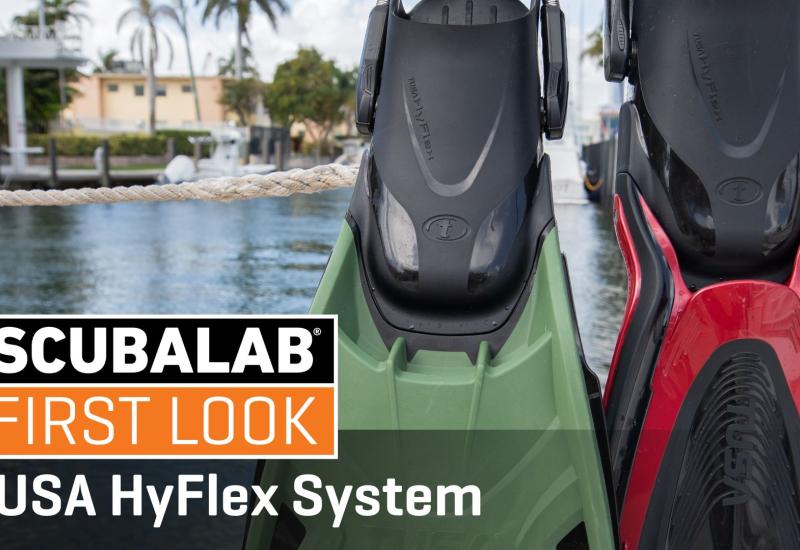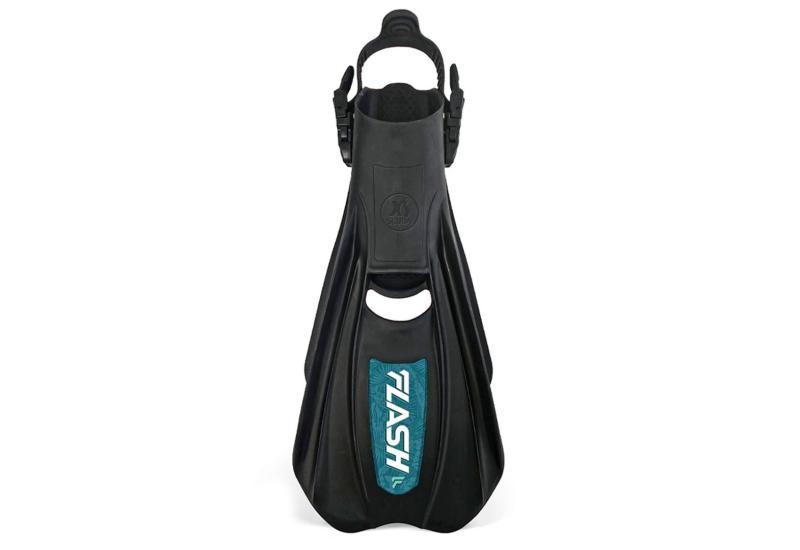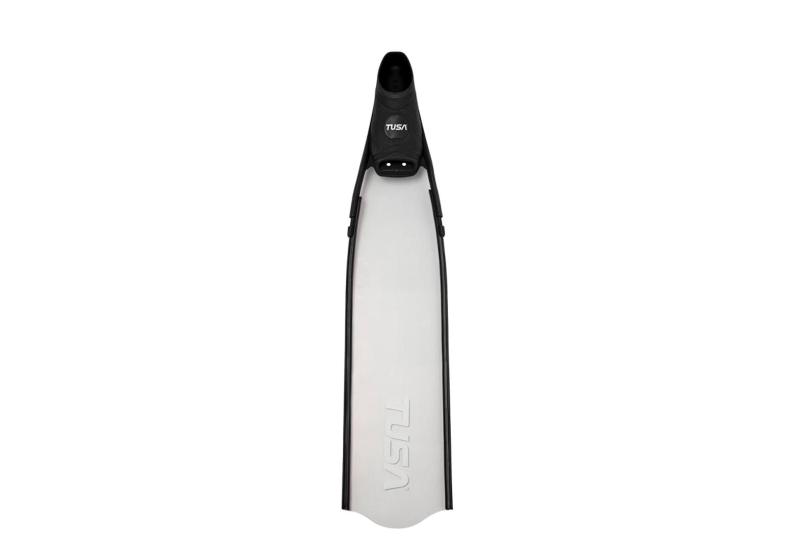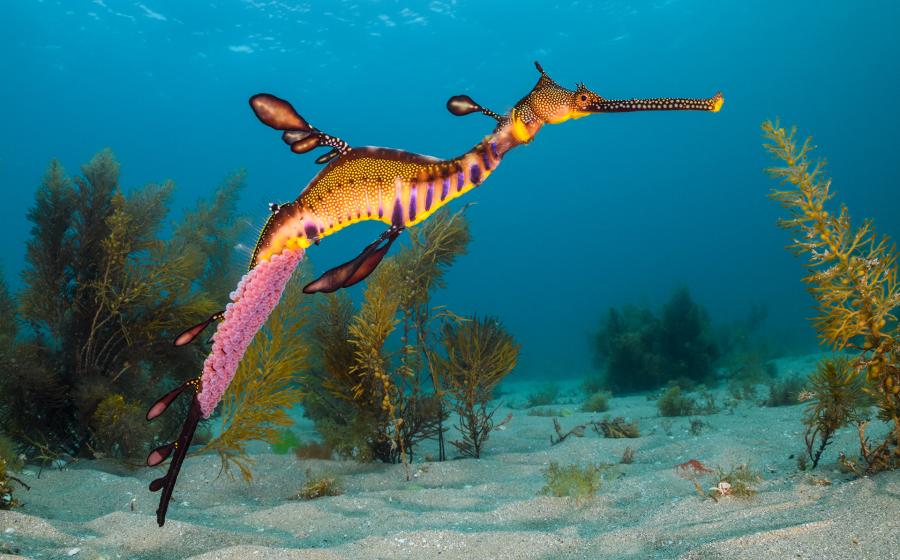Best Gear for U/W Shooters
I was recently doing a shoot on Grand Cayman and had some new dive gear for my models, including a pair of full-foot split fins (also known as "propeller fins"). My first roll of film was a pretty simple shot. We were swimming a short distance off the Sunset House property to photograph their new statue, Amphitrite, Queen of the Sea; so this was a good chance for me to try out the new fin technology as well.
I hit the water with a giant stride, grabbed my cameras and powered off to the statue with Sunset House's Keith Sahm leading the way. Keith is a big guy, about 6 feet, 4 inches, and had broad paddle fins on, so I figured he would set a pretty good pace. Even with a couple of cameras in tow, I was having no trouble keeping up using my propeller fins. So far, so good.
Then we got to the statue and I set up for the shot. Whoa! Something was very wrong. I felt clumsy and had a very hard time holding my position, even with an inanimate, stationary primary subject. I thought maybe there was some current, but I checked the other divers and the nearby gorgonians. No indication of current sweeping through, and no surge. The only extraneous variable here was my new fins, but since I was feeling very stylish and high-tech, I wasn't ready to abandon my new look.
The next day brought us to a magnificent submerged pinnacle off the East End. I spied a wonderful setup with red rope sponge draped over a large yellow tube formation. There was ample room to bring my model in on one side, but for me it was a pretty delicate position. I had to get into a tight opening and hold position with a light sculling motion to avoid touching nearby corals. There was no dead rock nearby to steady myself, and only good buoyancy control and precise fin motion would allow me to get the shot without damaging the reef. No problem, I assumed, having done just such a shot hundreds of times before.
I moved into the shoot zone, but again found myself clumsy and out of control. I couldn't concentrate on the shot because all my energy was directed toward trying to stay out of the coral. I gave up on that setup and moved on to another where my apparent inability to hover wouldn't matter.
Finally, it hit me. Propeller fins were terrific for swimming forward, but they were definitely not the answer for the delicate maneuvering I have to do as an underwater photographer. I swapped back to my trusty old paddle fins and once again I regained control. And it felt good!
Propeller Fins: No Thanks
This is just my opinion, with no research to back me up, but I think the propeller fins are great for moving forward with a forceful kick action. However, with very light finning motion, the water slips through the center vent and precise control is lost. Obviously there are those who are experts in testing scuba gear, and the results of Jon Hardy's thorough Scuba Lab reviews are a popular staple of this magazine. I don't dispute the conclusions he puts forth in the paddle fin review (June 2001) or the propeller fin review (July 2001). But what matters to me is not necessarily what works for most divers, but what works for me in the very specific pursuit of underwater images. To that end, paddle fins rule.
Other Optimal Gear for Underwater Shooters
Ergonomics and efficiency can make a huge difference when trying to capture an elusive image. Here are some more tips and gear choices that have helped me over the years:
Mask
Photography is all about the eyes. If you can't see it, you can't shoot it. I find a black, low-profile silicone mask absolutely imperative. Just as a photographer using a view camera in the field will drape a black cloth over his head and camera to keep light reflections away from the ground glass, the underwater shooter will find that a black mask pressed to the viewfinder improves contrast and critical focus. The popular clear silicone masks let too much light in through the sides, and forget about those fancy masks with windows on the side! They hold the eye too far away from the viewfinder and admit too much extraneous light.
In summary: Black to prevent unwanted light. Silicone for comfort and long life. Low profile so the eye sits close to the viewfinder when in shoot mode, and for enhanced peripheral vision in search mode.
Other Visual Enhancements
For those who wear eyeglasses, prescription lenses are a huge help. And for those with tired over-40 eyes that need reading glasses, close-focus devices called gauge-readers can help. These are small close-up magnifiers that can be glued in a lower corner of the mask to assist with reading frame counters and camera settings. A more elegant solution, now available from a few manufacturers, is a progressive bifocal with a close-up diopter in the lower part of the glass.
Finally, no matter how good the glass and mask skirt, if the mask continually fogs you'll have problems. Scour new masks, glass and skirt with Soft Scrub or an equivalent abrasive and use a dependable defogger before every dive.
Regulator
The underwater photographer has a few specific needs when it comes to regulators. Aside from effortlessly delivering air, whether at rest shooting clownfish or racing in pursuit of a whale shark, the regulator should deliver air in any posture. Whether we're right-side-up, upside-down or lying on our backs, photographers need to know they can easily draw air and that it will exhaust away from the viewfinder.
The regulator should not free flow; the sound of bubbles is annoying to the shooter and threatening to most fish. The style and finish of the second stage is a consideration as well, although again I have no empirical knowledge to support my belief that fish might be scared off by bright colors or garish designs. But I use a matte black finish because it works for me.
Buoyancy Compensator
The BC should be small and compact to travel well, yet provide sufficient lift for the conditions. Almost all my diving is in the tropics, so I use a slim-profile, rear-mount BC with plenty of sturdy D-rings so I can clip off cameras not in use. I like to have a small pocket to hold diffusers or dive lights, and an auto-inflator to quickly adjust trim when my hands are full of cameras. I recommend an alternate air source incorporated into the inflator hose rather than a separate octopus rig. The fewer hoses to snag the better when swimming through small caverns or in tight wreck penetrations.
Weight Integration
I do not recommend weight-integrated BCs for the underwater photographer. While the advantages of weight integration include comfort and lack of a separate weight belt, a significant downside is the weight of the whole weight/tank/BC assembly when handing it up to the boat crew. Since I do so much diving off chase boats on live-aboards, I prefer a separate weight belt. If necessary, I can hand the weight belt to a crew member and then the BC assembly, so I can easily board the dinghy. Also, I have watched photography students with weight-integrated BCs continually roll forward from the weight of their housed cameras or Nikonos RS systems. Weight belts allow greater trim options relative to specific camera systems. Divers who carry a heavy camera at the front can mount weights toward the back and better balance their center of gravity.
Wetsuits
I recommend diving with sufficient neoprene, even in tropical waters. Because underwater photographers often spend a long time in one position waiting for a subject to cooperate, warmth and comfort are crucial. A light dive skin or Polartec may provide ample thermal protection for a recreational diver constantly on the move, but an underwater photographer needs to dress more warmly than most.
Dive Computer
The dive computer is an essential accessory for any diver, not just photographers. But because the pursuit of images is often a multilevel endeavor, a good computer is all the more important. My preference is for a wrist-mounted hoseless unit so I don't have to take my hand away from the camera to pick up the computer at the end of the hose. And because photographers often push the limits of safe no-decompression diving, the computer should have a conservative algorithm. Then, just to be extra careful, I like to wear a redundant computer as well. That way, if the battery dies or one computer fails for any reason, I won't lose a day of diving trying to get my system back to ground zero for a fresh computer.
One note about hoseless computers: a strobe flash and recycle often interrupts a hoseless computer's air pressure readout. I've experienced plenty of situations where I have been in a shooting frenzy and forgot to look at my air pressure. It can be disconcerting to wrap a shoot at depth and have no idea that the display I am seeing means I'm out of air, or whether it will simply take a while for my computer to show me how much air I have because of electrical interference.
A distinct audible low-air warning is important in this instance. And if computer manufacturers come up with a way to keep the strobe recycle from interfering with the air readout, all the better.
I was recently doing a shoot on Grand Cayman and had some new dive gear for my models, including a pair of full-foot split fins (also known as "propeller fins"). My first roll of film was a pretty simple shot. We were swimming a short distance off the Sunset House property to photograph their new statue, Amphitrite, Queen of the Sea; so this was a good chance for me to try out the new fin technology as well.
I hit the water with a giant stride, grabbed my cameras and powered off to the statue with Sunset House's Keith Sahm leading the way. Keith is a big guy, about 6 feet, 4 inches, and had broad paddle fins on, so I figured he would set a pretty good pace. Even with a couple of cameras in tow, I was having no trouble keeping up using my propeller fins. So far, so good.
Then we got to the statue and I set up for the shot. Whoa! Something was very wrong. I felt clumsy and had a very hard time holding my position, even with an inanimate, stationary primary subject. I thought maybe there was some current, but I checked the other divers and the nearby gorgonians. No indication of current sweeping through, and no surge. The only extraneous variable here was my new fins, but since I was feeling very stylish and high-tech, I wasn't ready to abandon my new look.
The next day brought us to a magnificent submerged pinnacle off the East End. I spied a wonderful setup with red rope sponge draped over a large yellow tube formation. There was ample room to bring my model in on one side, but for me it was a pretty delicate position. I had to get into a tight opening and hold position with a light sculling motion to avoid touching nearby corals. There was no dead rock nearby to steady myself, and only good buoyancy control and precise fin motion would allow me to get the shot without damaging the reef. No problem, I assumed, having done just such a shot hundreds of times before.
I moved into the shoot zone, but again found myself clumsy and out of control. I couldn't concentrate on the shot because all my energy was directed toward trying to stay out of the coral. I gave up on that setup and moved on to another where my apparent inability to hover wouldn't matter.
Finally, it hit me. Propeller fins were terrific for swimming forward, but they were definitely not the answer for the delicate maneuvering I have to do as an underwater photographer. I swapped back to my trusty old paddle fins and once again I regained control. And it felt good!
Propeller Fins: No Thanks
This is just my opinion, with no research to back me up, but I think the propeller fins are great for moving forward with a forceful kick action. However, with very light finning motion, the water slips through the center vent and precise control is lost. Obviously there are those who are experts in testing scuba gear, and the results of Jon Hardy's thorough Scuba Lab reviews are a popular staple of this magazine. I don't dispute the conclusions he puts forth in the paddle fin review (June 2001) or the propeller fin review (July 2001). But what matters to me is not necessarily what works for most divers, but what works for me in the very specific pursuit of underwater images. To that end, paddle fins rule.
Other Optimal Gear for Underwater Shooters
Ergonomics and efficiency can make a huge difference when trying to capture an elusive image. Here are some more tips and gear choices that have helped me over the years:
Mask
Photography is all about the eyes. If you can't see it, you can't shoot it. I find a black, low-profile silicone mask absolutely imperative. Just as a photographer using a view camera in the field will drape a black cloth over his head and camera to keep light reflections away from the ground glass, the underwater shooter will find that a black mask pressed to the viewfinder improves contrast and critical focus. The popular clear silicone masks let too much light in through the sides, and forget about those fancy masks with windows on the side! They hold the eye too far away from the viewfinder and admit too much extraneous light.
In summary: Black to prevent unwanted light. Silicone for comfort and long life. Low profile so the eye sits close to the viewfinder when in shoot mode, and for enhanced peripheral vision in search mode.
Other Visual Enhancements
For those who wear eyeglasses, prescription lenses are a huge help. And for those with tired over-40 eyes that need reading glasses, close-focus devices called gauge-readers can help. These are small close-up magnifiers that can be glued in a lower corner of the mask to assist with reading frame counters and camera settings. A more elegant solution, now available from a few manufacturers, is a progressive bifocal with a close-up diopter in the lower part of the glass.
Finally, no matter how good the glass and mask skirt, if the mask continually fogs you'll have problems. Scour new masks, glass and skirt with Soft Scrub or an equivalent abrasive and use a dependable defogger before every dive.
Regulator
The underwater photographer has a few specific needs when it comes to regulators. Aside from effortlessly delivering air, whether at rest shooting clownfish or racing in pursuit of a whale shark, the regulator should deliver air in any posture. Whether we're right-side-up, upside-down or lying on our backs, photographers need to know they can easily draw air and that it will exhaust away from the viewfinder.
The regulator should not free flow; the sound of bubbles is annoying to the shooter and threatening to most fish. The style and finish of the second stage is a consideration as well, although again I have no empirical knowledge to support my belief that fish might be scared off by bright colors or garish designs. But I use a matte black finish because it works for me.
Buoyancy Compensator
The BC should be small and compact to travel well, yet provide sufficient lift for the conditions. Almost all my diving is in the tropics, so I use a slim-profile, rear-mount BC with plenty of sturdy D-rings so I can clip off cameras not in use. I like to have a small pocket to hold diffusers or dive lights, and an auto-inflator to quickly adjust trim when my hands are full of cameras. I recommend an alternate air source incorporated into the inflator hose rather than a separate octopus rig. The fewer hoses to snag the better when swimming through small caverns or in tight wreck penetrations.
Weight Integration
I do not recommend weight-integrated BCs for the underwater photographer. While the advantages of weight integration include comfort and lack of a separate weight belt, a significant downside is the weight of the whole weight/tank/BC assembly when handing it up to the boat crew. Since I do so much diving off chase boats on live-aboards, I prefer a separate weight belt. If necessary, I can hand the weight belt to a crew member and then the BC assembly, so I can easily board the dinghy. Also, I have watched photography students with weight-integrated BCs continually roll forward from the weight of their housed cameras or Nikonos RS systems. Weight belts allow greater trim options relative to specific camera systems. Divers who carry a heavy camera at the front can mount weights toward the back and better balance their center of gravity.
Wetsuits
I recommend diving with sufficient neoprene, even in tropical waters. Because underwater photographers often spend a long time in one position waiting for a subject to cooperate, warmth and comfort are crucial. A light dive skin or Polartec may provide ample thermal protection for a recreational diver constantly on the move, but an underwater photographer needs to dress more warmly than most.
Dive Computer
The dive computer is an essential accessory for any diver, not just photographers. But because the pursuit of images is often a multilevel endeavor, a good computer is all the more important. My preference is for a wrist-mounted hoseless unit so I don't have to take my hand away from the camera to pick up the computer at the end of the hose. And because photographers often push the limits of safe no-decompression diving, the computer should have a conservative algorithm. Then, just to be extra careful, I like to wear a redundant computer as well. That way, if the battery dies or one computer fails for any reason, I won't lose a day of diving trying to get my system back to ground zero for a fresh computer.
One note about hoseless computers: a strobe flash and recycle often interrupts a hoseless computer's air pressure readout. I've experienced plenty of situations where I have been in a shooting frenzy and forgot to look at my air pressure. It can be disconcerting to wrap a shoot at depth and have no idea that the display I am seeing means I'm out of air, or whether it will simply take a while for my computer to show me how much air I have because of electrical interference.
A distinct audible low-air warning is important in this instance. And if computer manufacturers come up with a way to keep the strobe recycle from interfering with the air readout, all the better.









